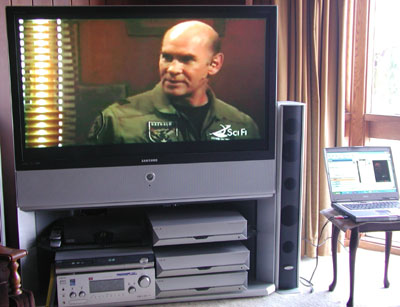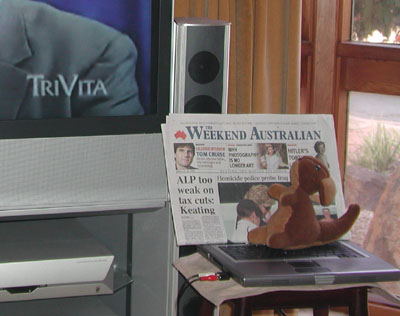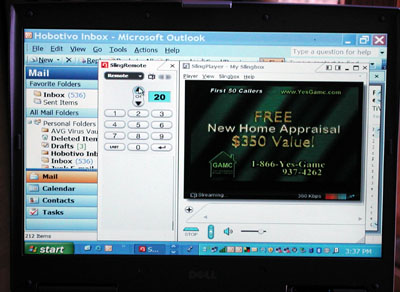
It’s been fairly well documented that you can Sling television feeds around the world, but Hobotech Ron and I wondered what type of quality one could expect outputting that signal to TV. So in the name of science, we broke several international laws to conduct an intercontinental experiment. Ron loaded up his Dell laptop with the SlingPlayer and viewed my Washington, DC-based Slingbox feed from his home in Canberra, Australia. As you can see above, video quality was decent on his rear projection TV with a consistent 320kbps-350kbps download bitrate (which is about what I get here in the US). We believe the limiting factor is not distance, but rather my DSL upload speed which is capped at 384kbps.
Ron says: I hooked it up to the RearPro via S-Video and my wife and I watched it for quite a while and came to the conclusion that, while less than perfect we would be quite happy to watch it, if it provided us with material we couldn’t get from any other source. A little bit like food, while one might prefer a steak, a hamburger will usually do quite well if that’s all that’s available!
The equipment below the screen is three Series 1 Sony TiVos with a total of 800GB of disk, all Ethernet connected, to the right is a Foxtel Satellite PayTV box, a Teac DVD recorder and a Sony Surround receiver. The speakers are from the Australian made Richter “Precious Metal” series.


I’ve just moved to Sydney from the US and have a desparate need to watch US College Football. If I can convince a friend in Dallas to ‘host’ a Slingbox on my behalf, would I be able to watch the things that he recorded for me?
Also – aren’t the local AUS broadband plans somewhat problematic b/c for $150 you only get X amount of data? Seems that 1-2 college games per month would eat up all the available space…
Aussie broadband is starting to catch up with the rest of the developed world – though nowhere near as fast as East Asia. New Zealand broadband is far worse – a shame, as Sling would be a great way for Kiwis to get TV from Australia, the UK or the US.
Aussie ISP plans aren’t as bad as they once were, but do read the fine print carefully. Telstra Big Pond is notorious for contracting you to a pathetically low download limit, and then hitting you for outrageous “excess download” fees. Get an agreement that won’t screw you like that. If they throttle back your delivery speed instead, that’s not so bad as a monthly bill that is off-the-planet… way more than you agreed to or planned for.